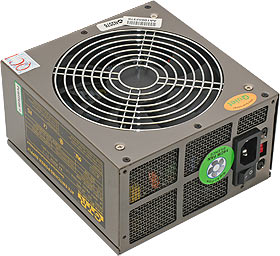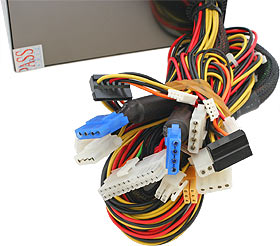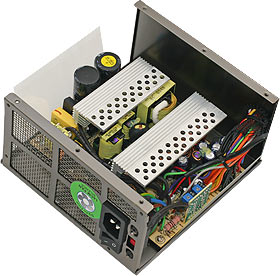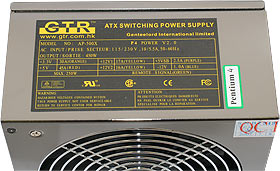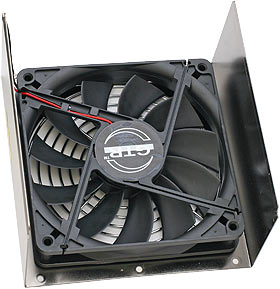
Quick Shot review 35:
GTR AP-500X Super Silent 450W PSU
Reviewer: Mark CocquioReview date: 15th January 2007. Last modified 03-Dec-2011.
For a few years now, my PC has been the A/V nerve centre of my house, as well as being my work and gaming machine.
As a result, I've been on a quest to develop a monstrously powerful PC which makes as little noise as possible.
In the end I settled on a fairly standard Lian Li case with a few special modifications in the fan department, about which I shall wax lyrical on another day. Suffice to say that, when the CPU is idle, the case fans spin slowly enough that they're barely audible.
When I was building it, my last hurdle was the noise from the power supply. To that end I specially sourced a fanless model (at fairly ridiculous expense) from the U.S.
It turned out to be a disaster.
When cool, it worked like a treat, but once it warmed up its voltages went haywire, resulting in all sorts of weird video glitches and ye olde blue screen of death.
The company involved were good enough to send me a second PSU, and when that didn't work, they refunded it completely, so I was only out of pocket for the postage (and, interestingly, they no longer seem to sell any fanless PSUs!).
So it was a valuable lesson: PC power supplies get hot, and they really do need a fan if you have a fairly stacked rig. Silent is nice, but stable is nicer, and it is not worth skimping on the quality of a power supply if you care at all about system stability.
[It's definitely possible for even quite powerful computers to run without a fan at all, but the system and case design you need to achieve this is very difficult to implement with PC components. Even Apple gave up on pure convection cooling a few years ago. -Dan]
Anyway, after the fanless fiasco I put the power supply thing out of my mind for a while, for various reasons. Then along came the silly season, and I decided that it would be nice to upgrade my video card.
My girlfriend would, according to our tradition, get my old card, a not-to-be-sneezed-at GeForce 6800GT, and I would get the shiny new 7800GS+, the fastest AGP card you could get before the AGP Radeon X1950 Pro came out.
For this, though, she'd need a bigger and better power supply, and therefore so would I.
So it was time to check out the current breed.
After I explained my primary requirements (cheapish, quiet and stable), the chaps at Aus PC Market pointed me at the GTR AP-500X power supply. This strangely named beastie is actually a 450W model, and is almost completely unremarkable, except for its rather large fan.
As you can see, it's extremely similar to the GTR 480W Modular PSU that Dan reviews here. In fact, it's almost exactly the same unit, but with a slightly lower output rating, and no modular connectors.
As a result, a lot of what Dan says about the modular PSU is also going to be applicable to this one. I shall point out the various differences and similarities as we go.
As I said, the most obvious difference is that this PSU doesn't have modular connectors. Instead, you get the usual bundle of spaghetti: Two SATA connectors, two floppy connectors, and eight of the old school four pin "Molex" connectors make up the bulk of the bundle.
You also get a six pin PCIe connector for your video card, as well as two more Molex connectors designated for video card use. These could easily be adapted to a 6-pin PCIe connector to allow a second video card (or monster dual-connector card) to be used.
Lastly, there is the standard four pin ATX auxiliary power connector, and the 20/24 pin main ATX connector. As Dan mentions in the other GTR review, the extra four pins can just hang off the edge of the connector if you have an older board. But in this case they go one better, and have a neat little hinge arrangement on the extra four pins so you can fold them out of the way and make the connector fit even if your motherboard has components near the ATX socket, without any unpleasantness.
Unlike the modular supply, the AP-500X doesn't have an eight pin EPS/SSI connector, but unless you're running a server motherboard with a Xeon or Opteron you'll be unlikely to miss it.
Like the modular supply though, the AP-500X does not come with its own power cable to plug it into the wall, so you'll need to grab one from your favourite source. The local op-shop or two-dollar-dodgy-brothers store are both good starting points.
Myself, I have accumulated an entire box of IEC leads, so I was happy to be able to put one to use.
Like the modular supply in Dan's review, the AP-500X is of an older, simpler design, without active power factor correction, and with a 115/230V input selection switch. As always - and especially if you're in a 220-240V country - double check this before plugging it in for the first time, to avoid letting the smoke out.
As you can see from the picture, the interior of this PSU is virtually identical to that of the modular supply, and the same comments apply about the monster fan doing the cooling quite adequately. More about that fan in due course.
Given that the AP-500X is rated at 450W, I had to do a bit of head scratching when I had a close look at the label. The ratings are actually very similar to those of the modular supply, with the exception of the 5V rail, which, according to the label, can put out 45A. Given that the 3.3V and 5V rails combined have a maximum output of 250W, I think perhaps that they meant 25A, or thereabouts.
[They could be telling something close to the truth, though; modern computers generally use the 12V and 5V rails for pretty much everything, efficiently regulating them down for low voltage things like powering the CPU, so a 5V/3.3V share biased strongly towards 5V is not crazy. -Dan]
Similarly, the two separate 12V rails add up to a startling amount of wattage. It's easy to get caught up in these figures, but they're rarely very accurate. Given that the overall rating of the power supply is 450w, they're being quite sensibly conservative when it comes to badging it.
At any rate, it's never a good idea to run a PC power supply at its maximum rated capacity, just like you shouldn't run an amp at 100% volume. What you need is a little bit of headroom, and for almost everyone 450w is plenty.
[A 450W-rated PSU should be enough to run any current non-overclocked single CPU, and any current video card. Multiple physical CPUs will need a bit more, though, and dual video cards can really push the envelope these days. Both Nvidia and ATI are making some 300 watt behemoth today, and to run a pair of those you'll need a PSU with a rating of 750W or more. And perhaps a new air conditioner for your computer room. -Dan]
Anyway, for me the crunch time test of the AP-500X was whether it would run my box stably. I have a reasonably elderly overclocked P4, a GeForce 7800GS, five hard drives and two optical drives, as well as a scattering of fairly highly powered fans. Under maximum load it pulls 300 to 350 (real) watts.
I also live in Brisbane, without air conditioning, so the heat is a factor too. Pleasingly, my system has been 100% stable under all loads and temperatures for some weeks now, so the stability box gets a big tick from me.
On to the noise factor.
As with the modular supply, the fan on this fellow is a 14cm whopper. It spins slowly, so it will last for a good long while, but its size also means that it will still move an appreciable amount of air. It is indeed very quiet.
Various power supply manufacturers quote noise figures for their products, and there's a bit of competition to see who can have the lowest number. In the real world, these numbers can serve as a guide, but you have to take them with a grain of salt.
For starters, power supply noise readings will vary depending on where you take them. A reading taken at the back of the PC will be different from one taken at the front, even if they're the same distance from the PSU. A reading taken from the power supply while it sits on a desk will be different again.
GTR claim the AP-500X puts out less than 25dB, which is very quiet indeed (comparable to a whisper).
I decided that, in the interests of science, it was finally time to justify purchasing a sound level meter. I ended up going with a fairly cheap one though, as the really sensitive ones cost many many dollars.
The downside of the cheap meter that I bought is that it doesn't measure anything softer then 30 dB, but this is not necessarily a problem, as I don't have an anechoic chamber handy to measure the PSU relative to (near) silence anyway.
The decibel scale is not absolute. Rather, it is used to define a ratio between two different amounts of (in the case of sound) acoustic energy. It's not a linear scale, but neither is human hearing, so the two map onto each other quite well.
Anyway, to some real world numbers. I took comparison readings with the GTR power supply and my old one, a two-8cm-fan Thermaltake of no particular pedigree.
First, I took a reading of the power supplies outside the PC, from 30cm (one foot) away, making sure the fans were similarly aligned and that the meter wasn't reading their breeze.
Next, I took readings with the PSUs inside my case, first with all the other fans set to minimum, and then with them switched off completely (which doesn't happen in the real world, but I wanted to see how quiet it could possibly be with just the hard drives and PSU fan going; many PCs still only have a PSU fan for ventilation, after all).
I took two readings each time, the first from 30cm in front of the case, and the second from the back, about 15cm from the power supply and to the side.
Ambient daytime noise in the (closed) room when I was taking these readings was 35-37dB. All the readings were taken with A-weighting, which takes into account the human ear's lower sensitivity to low frequencies.
The results:
| Old PSU | ||
| Front (dB) | Rear (dB) | |
| Fans low | 54 | 54 |
| Fans off | 52 | 50.5 |
| Outside | 46 | |
| GTR AP500-X | ||
| Front (dB) | Rear (dB) | |
| Fans low | 51.5 | 51.5 |
| Fans off | 49 | 47.5 |
| Outside | 40 | |
So, at the end of the day, my PC is roughly 3dB quieter with the new power supply. Three lousy decibels may not seem like much, and it isn't. In fact, it's the generally accepted minimum amount of change your average cloth-eared punter can detect in normal (i.e., outside a lab or very quiet environment) circumstances, with one decibel being the minimum amount of difference anybody can ever consistently detect.
Maybe I have golden ears, or am particularly sensitive to fan noise (or, more likely, I am just plain fooling myself), but the room is noticeably quieter now when the PC is on. Even if my brain is exaggerating the extent of the change in volume, the readings prove that it's real, if only to a minimal extent.
So the AP-500X gets a tick in the quietness box too.
Overall
All up, there isn't all that much you can say about most power supplies, and the AP-500X drops firmly into the Less Exciting Basket. What it does do though, it does well: it seems reliable, is very quiet, and has a decent power rating, suitable for all but the most ridiculous Tiny Gods.
It is also cheap. Aussies can get one delivered from Aus PC Market for only $AU110. So it earns a Recommended from me, despite that missing power cord.
Aus PC Market no longer stock the AP-500X.
Their
PSU department has lots of other options, of course.
